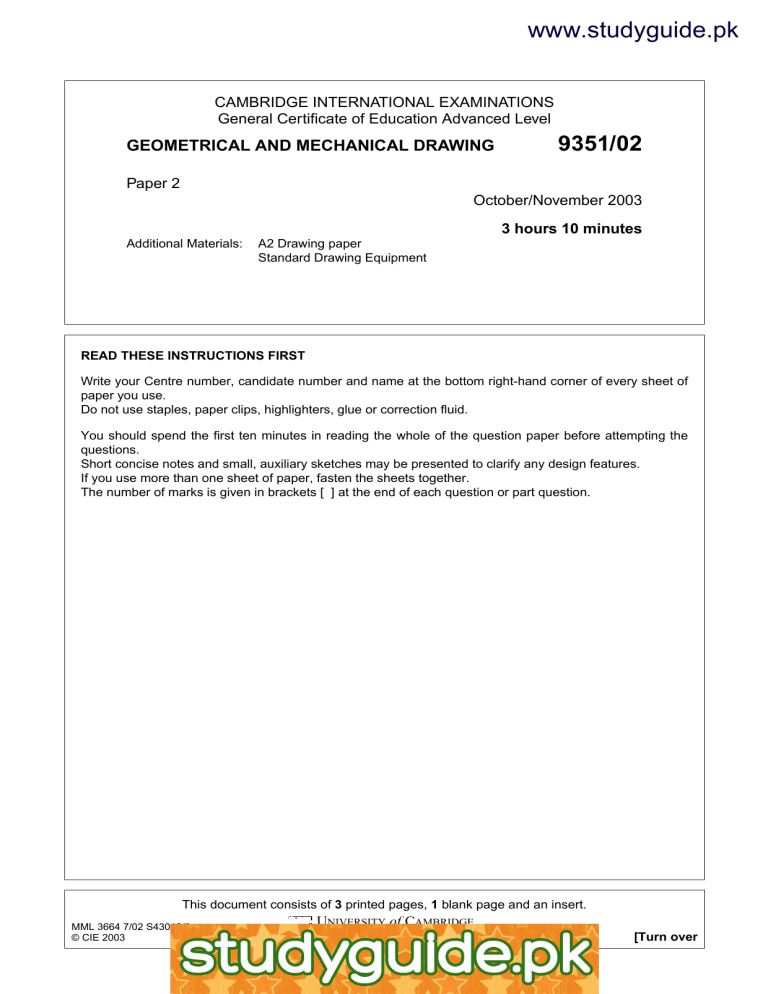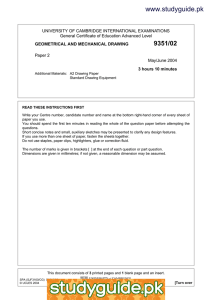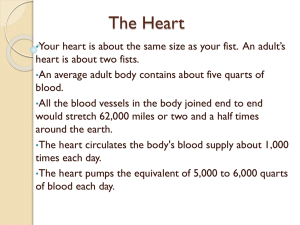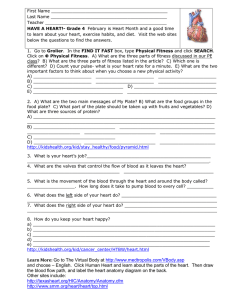www.studyguide.pk 9351/02 GEOMETRICAL AND MECHANICAL DRAWING

www.studyguide.pk
CAMBRIDGE INTERNATIONAL EXAMINATIONS
General Certificate of Education Advanced Level
GEOMETRICAL AND MECHANICAL DRAWING
9351/02
Paper 2
October/November 2003
3 hours 10 minutes
Additional Materials: A2 Drawing paper
Standard Drawing Equipment
READ THESE INSTRUCTIONS FIRST
Write your Centre number, candidate number and name at the bottom right-hand corner of every sheet of paper you use.
Do not use staples, paper clips, highlighters, glue or correction fluid.
You should spend the first ten minutes in reading the whole of the question paper before attempting the questions.
Short concise notes and small, auxiliary sketches may be presented to clarify any design features.
If you use more than one sheet of paper, fasten the sheets together.
The number of marks is given in brackets [ ] at the end of each question or part question.
MML 3664 7/02 S43012/2
© CIE 2003
This document consists of 3 printed pages, 1 blank page and an insert.
U
NIVERSITY
of C
AMBRIDGE
Local Examinations Syndicate
http://www.xtremepapers.net
[Turn over
www.studyguide.pk
2
RELIEF VALVE
The given drawings show the components of a RELIEF VALVE. The automatic valve is a safety device which is used to prevent undesirable over-pressure in a pipe line.
Method of Assembly
The VALVE SEAT is fitted in recess A of the BODY and the VALVE is fitted in the VALVE SEAT
The GLAND is secured in the top of the COVER PLATE using two M 10 studs with hexagonal nuts and spring washers (not shown). Note that only the height that the GLAND protrudes above the
COVER PLATE is given. The overall size of the GLAND will depend on your solution to Design
Feature (iii).
The two PILLARS are screwed into the top of the COVER PLATE and the CROSS HEAD is secured on the PILLARS using plain washers and hexagonal nuts (not shown).
The VALVE SPINDLE is fed upwards in the assembled COVER PLATE and GLAND. The SPRING
ASSEMBLY is positioned with the top of the VALVE SPINDLE in the blind hole B of the LOWER
SPRING CARRIER.
The COVER PLATE is now attached to the top flange of the BODY.
The UPPER SPRING CARRIER will now be in contact with the underside of the CROSS HEAD and the spherical end of the VALVE SPINDLE will be holding the VALVE down on its seat.
To complete the required views, a number of design features need to be considered. Modifications will need to be made to the given components and it is essential that the designed items are drawn clearly on the required views. These should be supported by annotated sketches, suitably positioned on your answer sheet.
The design features are:
(i) a method of securing the COVER PLATE to the top of the BODY, suitably sized and positioned to maintain maximum strength in the assembled relief valve; [5]
(ii) a method of securing the UPPER SPRING CARRIER centrally positioned under the
CROSS HEAD. The method used MUST also provide a means of tightening the compression of the SPRING by a maximum of six millimetres. In addition, any adjustment must be able to be locked in position; [10]
(iii) an appropriate method of preventing water leaking at the VALVE SPINDLE and the
VALVE.
[5]
9351/02/O/N/03
www.studyguide.pk
3
Answer the following questions using either first or third angle orthographic projection.
1 Draw, to a scale of 1:2, the following views of the assembled Relief Valve.
(a) a front view with the body positioned as given in the question paper: the left hand side of the vertical centre line is to be an outside view and the right hand side a sectional view taken on the cutting plane TT; [48]
(b) an outside end view in the direction of arrow X. Include the SPRING CARRIERS but do not show the spring in this view.
[23]
2 Draw the symbol of projection used for your answer in accordance with BS 308 or PP 7308, in the bottom right hand corner of your answer sheet.
[2]
3 Complete a parts list tabulating all parts complete with suitable materials from which they might be made.
[7]
NOTE
1 Hidden detail is not required on any view.
2 Sizes not shown are left to your own discretion.
9351/02/O/N/03
4
BLANK PAGE www.studyguide.pk
9351/02/O/N/03





